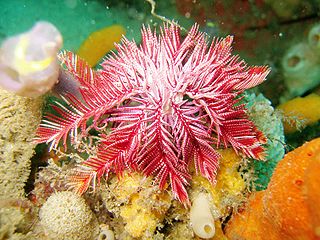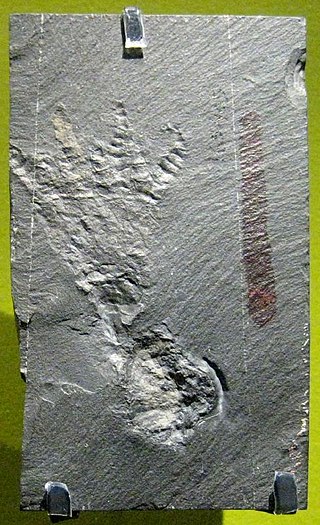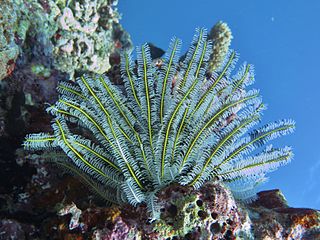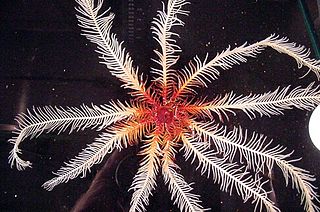
Crinoids are marine invertebrates that make up the class Crinoidea. Crinoids that remain attached to the sea floor by a stalk in their adult form are commonly called sea lilies, while the unstalked forms, called feather stars or comatulids, are members of the largest crinoid order, Comatulida. Crinoids are echinoderms in the phylum Echinodermata, which also includes the starfish, brittle stars, sea urchins and sea cucumbers. They live in both shallow water and in depths over 9,000 metres (30,000 ft).

Articulata are a subclass or superorder within the class Crinoidea, including all living crinoid species. They are commonly known as sea lilies or feather stars. The Articulata are differentiated from the extinct subclasses by their lack of an anal plate in the adult stage and the presence of an entoneural system. Articulata first appeared in the fossil record during the Triassic period although other, now extinct crinoid groups, originated in the Ordovician.

The stylophorans are an extinct, possibly polyphyletic group allied to the Paleozoic Era echinoderms, comprising the prehistoric cornutes and mitrates. It is synonymous with the subphylum Calcichordata. Their unusual appearances have led to a variety of very different reconstructions of their anatomy, how they lived, and their relationships to other organisms.

Comasteridae is a family of crinoids.

Echmatocrinus is a Cambrian animal which resembles a crinoid or an octocoral. Its exact taxonomy is still a subject of debate. It is known only from the Burgess shale. Around 20 specimens of Echmatocrinus are known; these comprise < 0.02% of the community.
Pelmatozoa was once a clade of Phylum Echinodermata. It included stalked and sedentary echinoderms. The main class of Pelmatozoa were the Crinoidea which includes sea lily and feather star.

Comatulida is an order of crinoids. Members of this order are known as feather stars and mostly do not have a stalk as adults. The oral surface with the mouth is facing upwards and is surrounded by five, often divided rays with feathery pinnules. Comatulids live on the seabed and on reefs in tropical and temperate waters.

Comaster schlegelii, the variable bushy feather star, is a crinoid in the family Comatulidae. It was previously classified as Comanthina schlegeli but further research showed that it was better placed in the genus Comaster. It is found on shallow water reefs in the western Pacific Ocean.

Bourgueticrinida is an order of crinoids that typically live deep in the ocean. Members of this order are attached to the seabed by a slender stalk and are known as sea lilies. While other groups of crinoids flourished during the Permian, bourgueticrinids along with other extant orders did not appear until the Triassic, following a mass extinction event in which nearly all crinoids died out.

Cladida is a major subgroup of crinoids with a complicated taxonomic history. Cladida was originally applied to a wide assortment of extinct crinoids with a dicyclic calyx. Under this original definition, cladids would represent a paraphyletic order ancestral to several other major crinoid groups, particularly the living Articulata. More recently, Cladida has been redefined as a monophyletic parvclass of pentacrinoids which encompasses articulates and the extinct Flexibilia (flexibles). Cladids also include various minor taxa such as the hybocrinids and "cyathocrines". As flexibles were not originally considered cladids, the new subgroup Eucladida has been erected for cladids which are more derived than flexibles. Cladida is the sister group to Disparida, another large group of extinct crinoids.

The Camerata or camerate crinoids are an extinct subclass of Paleozoic stalked crinoids. They were some of the earliest crinoids to originate during the Early Ordovician, reached their maximum diversity during the Mississippian, and became extinct during the Permian–Triassic extinction event. Camerates are the sister group of Pentacrinoidea, which contains all other crinoids. The two largest camerate subgroups are the orders Diplobathrida and Monobathrida.

Isocrinida is an order of sea lilies which contains four extant families.

Agaricocrinus is a genus of extinct crinoids, belonging to the family Coelocrinidae.

The Verulam Formation is a geologic formation and Lagerstätte in Ontario, Canada. It preserves fossils dating back to the Katian stage of the Ordovician period, or Shermanian to Chatfieldian in the regional stratigraphy.
Paleontology or palaeontology is the study of prehistoric life forms on Earth through the examination of plant and animal fossils. This includes the study of body fossils, tracks (ichnites), burrows, cast-off parts, fossilised feces (coprolites), palynomorphs and chemical residues. Because humans have encountered fossils for millennia, paleontology has a long history both before and after becoming formalized as a science. This article records significant discoveries and events related to paleontology that occurred or were published in the year 2018.

Aporometra wilsoni is a marine invertebrate, a species of crinoid or feather star in the family Aporometridae. It is found in shallow water around the coasts of southern Australia.

Notocrinus virilis is a marine invertebrate, a species of crinoid or feather star in the family Notocrinidae. It is found in deep water in the Southern Ocean around the coasts of Antarctica and adjacent islands. A sea snail sometimes parasitizes it.

Pentacrinoidea is a subclass of crinoids containing all members of Crinoidea except for the exclusively Paleozoic camerates. It was originally named in 1918 by Otto Jaekel, who hypothesized a fundamental split between camerate and non-camerate crinoids. Later workers doubted this interpretation, and Pentacrinoidea was rarely used during the rest of the 20th century. Recent phylogenetic work has provided strong support for Jaekel's hypothesis, and Pentacrinoidea was reinstated in a 2017 revision of crinoid systematics.

Flexibilia is a superorder of specialized Paleozoic crinoids. They exhibited a conserved body plan and consistent suite of characteristics throughout their long history. Previously considered a subclass with unclear affinities, later investigation determined that flexibles are well-nested within Cladida, a broad group ancestral to living articulate crinoids. The Ordovician cladid Cupulocrinus acts as an intermediate form linking the generalized anatomy of other early cladids with the distinctive anatomy of flexibles, and several studies have considered it to be ancestral to the rest of the group. Although flexibles never reached the same abundance or diversity as many other crinoid groups, they remained a reliable component of crinoid faunas, particularly from the Silurian onwards. Flexible fossils are very rare in the Ordovician, but the Late Ordovician appears to have been an interval of rapid diversification for the group.

















